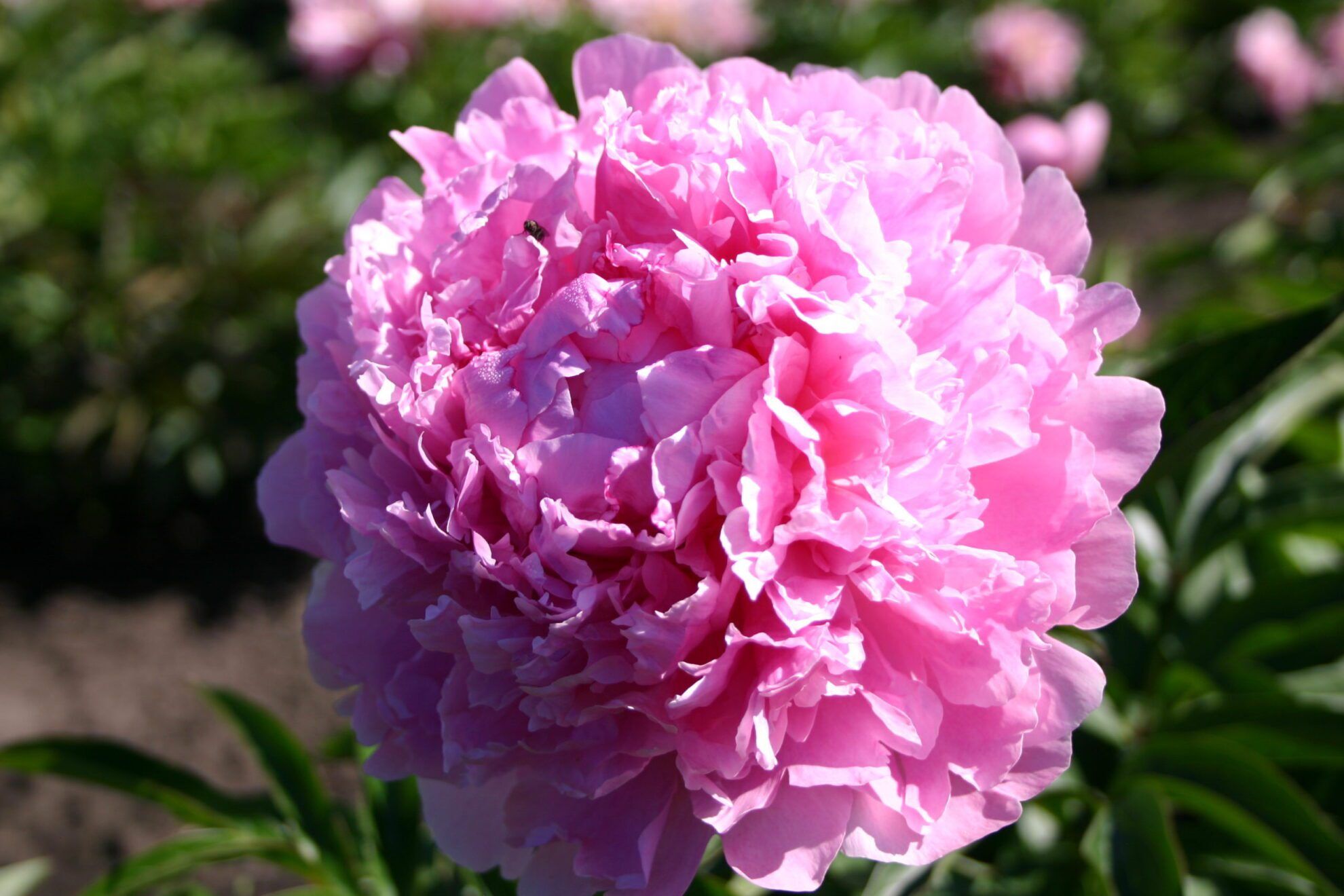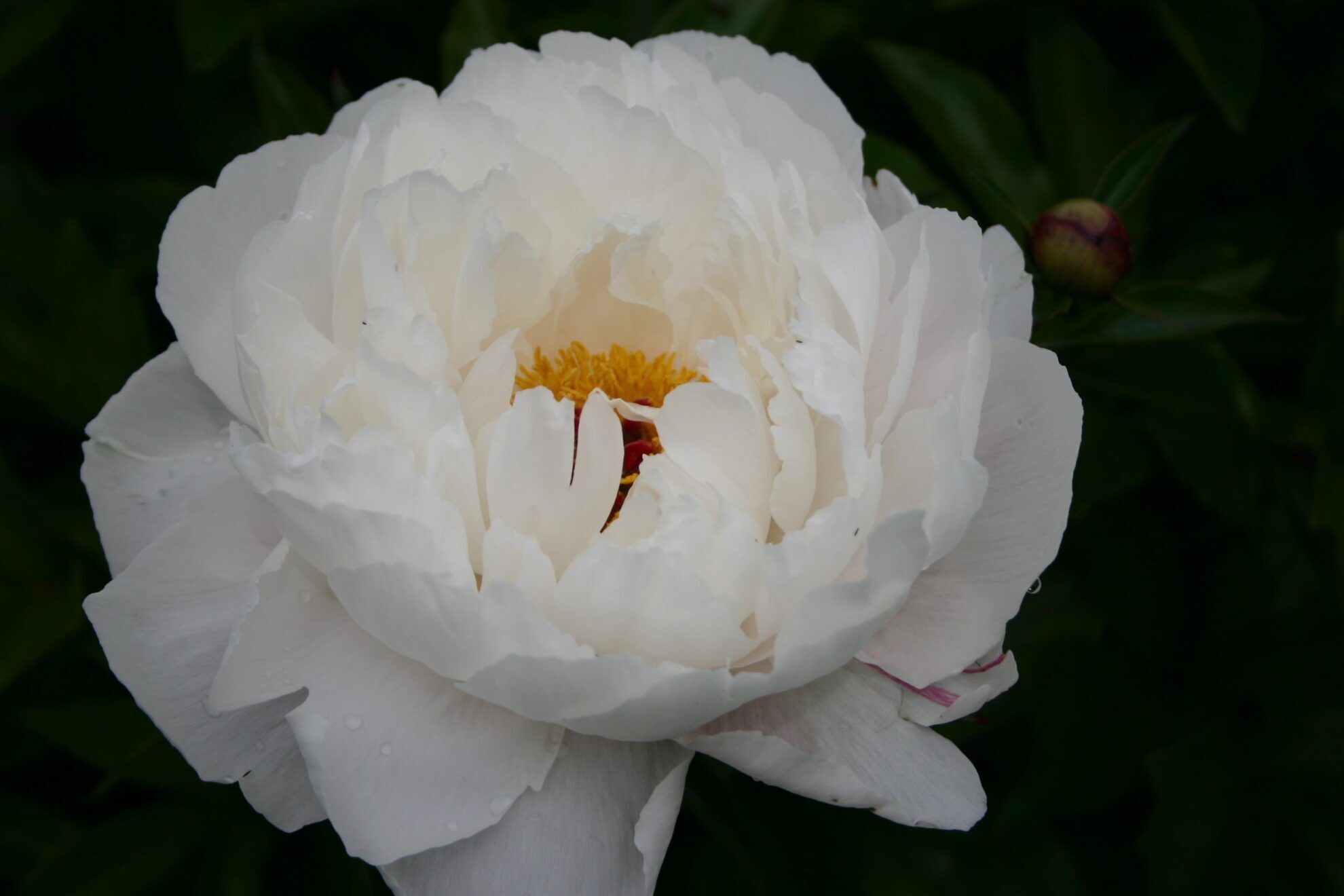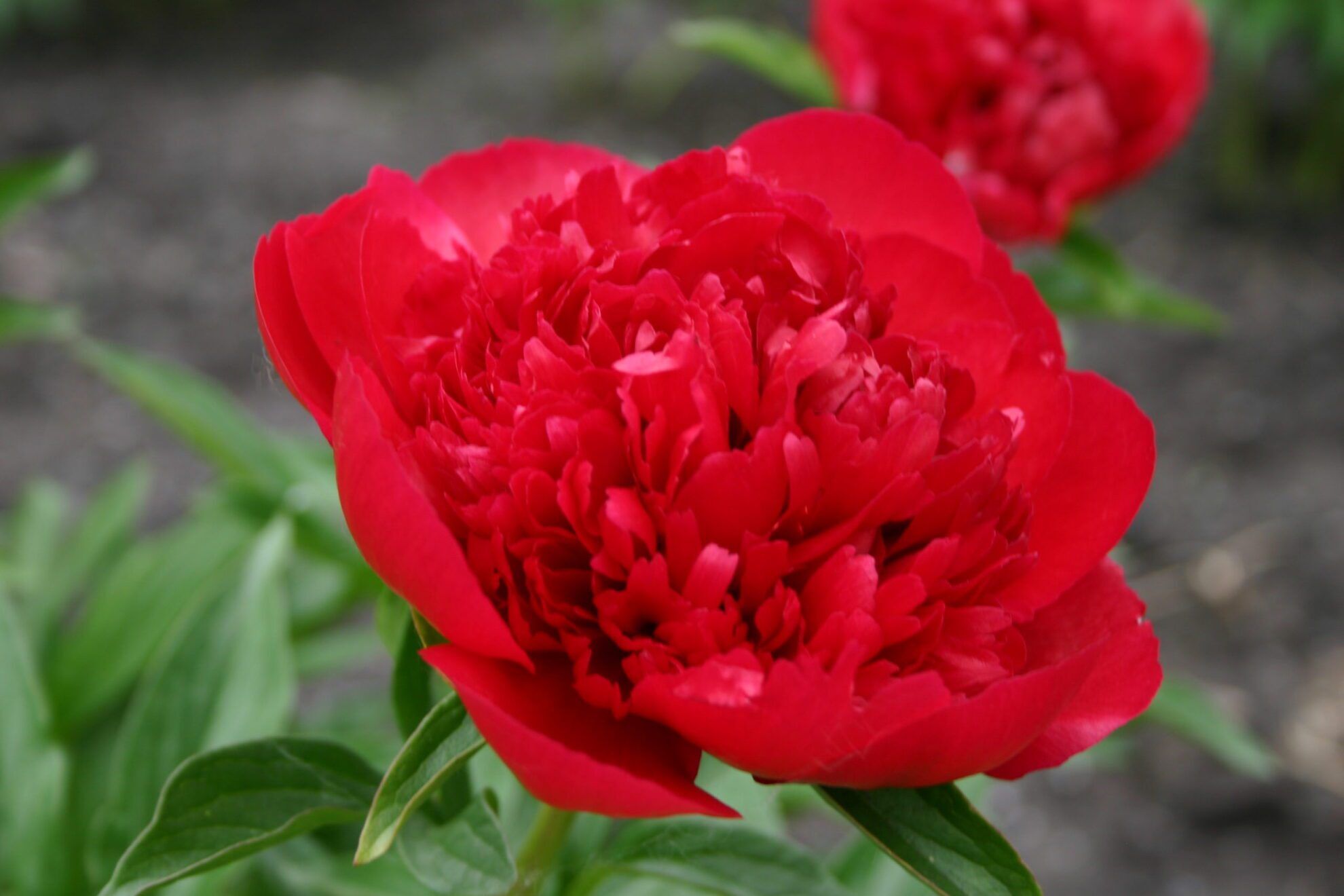1. What Types of Peonies do you sell?









1a. Herbaceous Peonies
We specialize in Herbaceous Peonies, they grow in zones 3-8, andcome in a wide variety of colors, fragrance, and flower forms, like double, semi double, japanese, bomb, anemone, and single. Herbaceous peonies are the most well-known type of peony grown in our northern climate. They are very disease resistant, require very little care, resistant to many insect pests, and deer and rabbit resistant as well. These attributes makes peonies an ideal choice for our garden. In our climate, peonies peak bloom is late June to early July, but herbaceous peonies do not all bloom at the same time, some bloom early, some mid-season, and some varieties have a very late blooming period. To extend your blooming period you should plant peonies that have different blooming times. Depending on weather conditions, your peonies should bloom on average for 7-10 days. Once the bloom is finished the green leaves remains throughout the summer, dies back to the ground in winter and reemerges early each spring. It is very important that you cut your peony stems in the fall to prevent fungal disease like botrytis. We recommend that you plant peonies in the fall, when the plants are dormant and can be transplanted easily. If you need to move a peony in the spring, it is best to move your peony before the plant start to grow, this way you prevent damaging any growing shoots. Peonies require 6-8 hours of full sun per day, and should be planted in rich well drained soil. They are prolific bloomers, generally depleting the soil after many years; working in a small amount of compost around your peonies each year will help your soil maintain nutrients, and allow your peony to flourish year after year. Once established your peonies will prosper for many years, it is not uncommon for a peony plant to live more than 50 years. Currently more than 5,000 cultivars of peonies have been registered and even more have been named. This gives us a great selection of peonies for our gardens.


1b. Herbaceous Species
Herbaceous Species, belong in the genus Paeonia, they are plants that occur naturally in the wild, native to Asia, Europe and Western North America. All peony cultivars are derived from the species group. Species or ‘Wild Botanical Peonies’, belong to the genus Paeonia family,they are plants that occur naturally in the wild, native to Asia, Europe and Western North America. There are about 30 species that occur naturally in the world, which fall into two distinct groups. The first group is made up of shrubby or tree peonies, also known as Moutan. We do not grow or offer tree species for sale, as they require a more temperate climate, which we cannot give them. The second group belongs to the herbaceous species, these are plants that die back to the ground each year in fall. We offer a good selection of herbaceous species from this group. Species are rarely offered for sale as most are threatened, endangered or extinct now in their natural habitats.The varieties we offer for sale have been propagated by root division for many years, or grown from seed. Herbaceous species are somewhat more demanding in their growing requirements than garden peonies, and require excellent drainage, doing well in rock garden setting, with dappled shade. Many species grow naturally in wooded areas, along forest edges, in wild meadows, while others only grow at high altitudes in mountain ranges. For these reasons species bloom early, extending the blooming season, as they bloom well before herbaceous garden varieties. Flower types are generally single, or semi double and the leaf form varies greatly from the many species. Fern leaf, saw-toothed, lobed, or ovate leaf structure is just another reason why species are so attractive in our garden landscape. The herbaceous species we offer for sale are extremely hardy, withstanding zone 2 climate, and have bloomed successfully in our chinook climate. Knowing specific requirements will provide years of success with these plants.


1c. Intersectional Peonies
Intersectional Peonies, also known as Itoh peonies in honor of Toichi Itoh, are a relatively new peony hybrid, they are created by crossing a tree peony with an herbaceous peony. These peonies produce tree peony flowers and leaves on plants that behave like herbaceous peonies, dying down to the ground in winter and reemerging each spring. When mature these plants create large flowers on a sturdy stem that does not require support. Intersectional peonies extend the blooming season, as they reach peak bloom near the end of the herbaceous peony bloom. Each plant can remain in bloom for 2-3 weeks as new side buds continue to open over this period. They come in a wide variety of color not widely available in herbaceous peonies, including an array ofblended colors, pastels, yellows and golds.These colors are more indicative of tree peonies. Growing to approximately 2-3 feet tall by about 3 feet wide. Their compact form is well suited to the front of the perennial boarder as they produce leaves and flowers that cover the entire plant. Largeflower size, easy of growing, disease resistant, especially to botrytis, resistant to many insect pests, deer and rabbits, make them the ideal choice for your perennial border.These plants are not fertile and therefore will not produce viable seeds. The spent blooms can be cut to clean up the plant look, and to provide more energy to next year’s plant. Our collection of Intersectional Peonies is always growing with a selection of over 30 varieties to choose from, you will be sure to find something for your perennial garden.


2. What is the difference between herbaceous peonies and tree peonies?
Herbaceous peonies die down to the ground level in fall with new growth emerging in spring. Tree peonies are shrubs producing woody shoots that remain above ground year round.
3. Will deer eat myherbaceous peonies?
If you’re looking for a flowering plant that deer won’t eat, growing peonies is an excellent choice. Herbaceous peonies are toxic to deer and rabbits and they generally stay away from this plant. Tree peonies on the other hand do not produce the same type of toxins in the foliage and are consumed by both deer and rabbits.
4. When is the best time to move peonies?
Fall is the best time to move and divide your peonies. We do this when the plant is in a dormant stage of its growing cycle. Optimal time is when the foliage starts to die back and turn brown. Plants will then settle into their new location, set feeder roots for next year’s growth cycle. Cutting back all vegetation to the ground each fall is good practice to prevent fungal disease like botrytis.
5. What are the black spots on my peony?
Botrytis gray mold and leaf blotch are the two most common fungal diseases of peonies. These fungal diseases can infect every part of the plant. (foliage, stems, flowers and even root system). They show up as purple/black or brown spots on your plant’s foliage. Symptoms may include early season, collapse of stem due to dark brown soft rot at base of stem, dark brown spotting on foliage, small purple-red irregular fleck shapes on plants and or drying of foliage early in the season, bud blast, buds turn brown and rot before they have a chance to open.
Infected plant stock, or decayed peony foliage left overwinter, spores in soil, cool wet weather conditions favored by botrytis, with excess moisture on plants or ground are some of the main causes for these diseases.
To reduce and mitigate fungal diseases, reduce leaf wetness, limit overhead watering, plant in airy location, limit overcrowding, cut and remove all peony plant debris in fall, and remove all infected plant parts. Spray a fungicide of infected plants will help eliminate fungal disease. When unsure consult a reputable local garden center in your area for a recommendation on control measures.
6. Should I be worried about the ants on my peonies?
Ants love a sugary treat! The buds of peonies secrete a sweet substance, much like liquid syrup. This liquid is what attracts the ants to your peony plants. You will find many ants sipping the sweet substance, but ants do not harm the peony bud itself in any way. The sticky substance is there to protect the bud while it is developing, and getting ready to bloom. When your peony is ready to open this liquid substance disappears slowly by itself. In a way the ants help speeds up the blooming process.
Ants can be a big problem when they decide to nest under your peony plant. They create multiple small tunnels above and within the root zone of your peony. This becomes a problem because the peony loses moisture, as not all roots are in contact with the soil, the area dries out very quickly, leading to a slow death of hydration for your peony plant. There are many insecticides on the market that will help eliminate an ant problem. Contact your local nursery or hardware store for some trusted methods.
7. Why does my peony not produce any flowers?
There are a few reasons why your peony might not bloom for you. The first reason might be that your peony is not in a mature state to produce flowers. Often peonies purchased in garden centres are smaller plant that are a few years away from blooming. They may have a smaller root system, usually based on the pot size, which also prevents them to hold enough energy that blooming requires.
Other reasons your peony might not bloom, is the location in which you planted. Choosing the right location for your peony is the most important element for the success of your plant. Peonies like well-drained, rich soil, and if your plant is in a wet location with not enough drainage, your plant will probably not be happy, and not produce any flowers. They also require a sunny location that receives at least 6-8 hours of sunlight daily. Making sure your peony plant is not too close to larger trees or shrubs as these plants use up moisture in the area, leaving the peony plant very dry and stressed. If your peony plant is planted too deep it will not produce any blooms for you. When planting your peony roots, make sure that the peony eyes are 1- 11/2 inches below the soil surface.
We ship peony roots with 3-5 eyes that have a tendency to bloom the following year. It is in your best interest to cut off all flowering blooms the first year, leaving only the green foliage, so the energy going back into developing a stronger root system and plant for the following growing season. In the second year after planting the root system will be strong enough to support a strong blooming plant.
8. Can I store peony flowers for later use?
Yes, peony flower buds can be stored in cold treatment like your kitchen refrigerator, for later use. You can hold the flower buds for two to three weeks, for most varieties, and up to 2 months for varieties that are better suited for cutflower production, with the right temperature requirements. They can be stored dry in a sealed plastic bag to keep in moisture, or kept in a reservoir of water if space permits.
The cold slows down development of the plant and prolongs plant storage. Ideal temperature should be around 0-1 degree Celsius. If this is not possible ffrom your kitchen refrigeration, the holding time will be reduced.
Flowers should be cut when the buds are in a soft, marshmallow state, and the majority of leaves should be cut at this time to prevent water needs. Place the bud in between your two fingers to test if the bud is soft enough, and ready for storage. If the peony bud is too soft, the flower will open sooner and will not last in long term storage.If the bud is too hard the peony might not open properly once moved out of storage.
When it is time to enjoy your peonies, take them out of cold storage, cut the end of the stems and place them in tepid water, placing them in a cool room to open. Your peonies will start taking on water and bloom as beautifully as freshly cut peony flowers.
We offer a good selection of cut flowers, as we are looking to extend our peony business to provide cut flowers to our customers.
SHOP CUT FLOWER PEONIES


